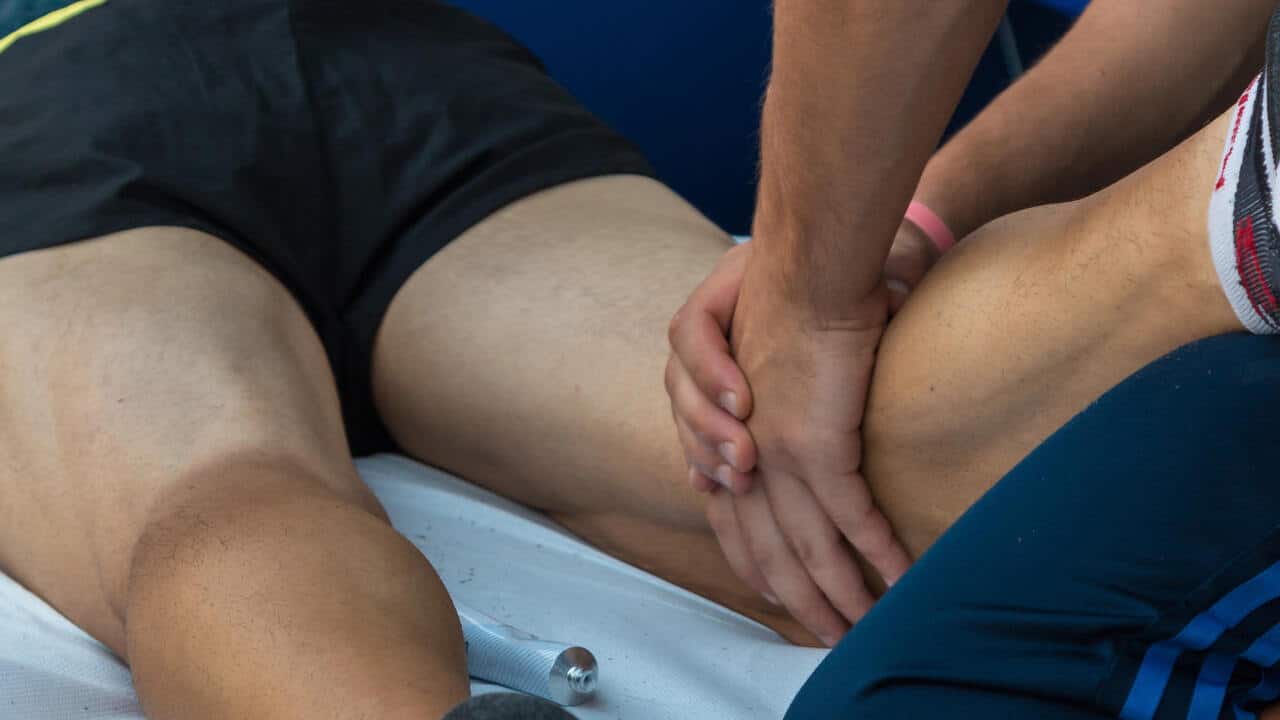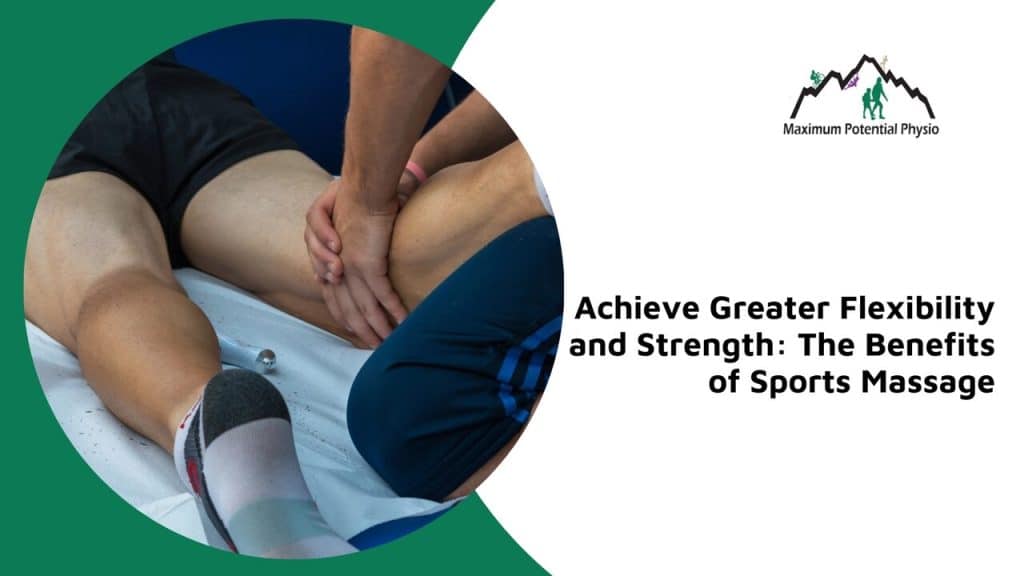Achieve Greater Flexibility and Strength: The Benefits of Sports Massage

Sports massage is a specialized form of massage therapy designed to meet the needs of athletes and active individuals. Whether you’re a professional athlete, a weekend warrior, or someone who enjoys staying active, sports massage can play a crucial role in improving performance, speeding up recovery, and reducing the risk of injury. In this blog post, we’ll explore the benefits of sports massage, the techniques commonly used, and how often athletes should get a sports massage.
Exploring the Benefits of Massage for Sports
Sports massage offers a range of benefits that can enhance athletic performance and support overall physical health. Here’s how it can help:
- Improved Flexibility and Range of Motion: Regular sports massage helps keep muscles and connective tissues flexible, which is essential for maintaining a full range of motion. Improved flexibility allows athletes to perform movements more efficiently and reduces the risk of strains and other injuries.
- Enhanced Performance: By targeting specific muscle groups used during physical activity, sports massage can help optimize muscle function. This leads to better performance, whether you’re lifting weights, running, or playing a sport. Massage also helps increase circulation, delivering more oxygen and nutrients to the muscles, which can boost endurance and strength.
- Faster Recovery: After intense physical activity, muscles can become tight, sore, and fatigued. Sports massage helps to alleviate muscle tension, reduce soreness, and promote quicker recovery by enhancing blood flow and lymphatic drainage. This allows athletes to return to training or competition sooner and with less discomfort.
- Injury Prevention: One of the key benefits of sports massage is its ability to prevent injuries. By identifying and addressing muscle imbalances, tightness, and areas of stress, sports massage helps maintain muscle health and reduce the likelihood of injuries such as strains, sprains, and overuse injuries.
- Stress Reduction: Physical activity, especially at a high level, can lead to both physical and mental stress. Sports massage not only helps relieve physical tension but also promotes relaxation and mental clarity. This holistic approach supports overall well-being and helps athletes stay focused and motivated.
- Pain Relief: For athletes dealing with chronic pain or recovering from an injury, sports massage can provide effective pain relief. Techniques used in sports massage help reduce inflammation, release tight muscles, and improve the body’s natural healing processes, leading to a reduction in pain and discomfort.
Commonly Used Techniques for Sports Massage
Sports massage incorporates a variety of techniques designed to address the specific needs of athletes and active individuals. Here are some of the most commonly used techniques in sports massage:
- Deep Tissue Massage: This technique involves applying firm pressure to reach the deeper layers of muscle and connective tissue. Deep tissue massage is particularly effective for breaking down scar tissue, relieving muscle tension, and addressing chronic pain. It’s often used to target specific problem areas where athletes experience tightness or discomfort.
- Active Release Techniques: Active release is a specialized technique used to treat muscle tightness and dysfunction. It involves identifying and releasing adhesions in the muscles, tendons, and ligaments, which can restrict movement and cause pain. This technique is particularly beneficial for athletes dealing with overuse injuries or chronic muscle tension.
- Athletic Injury Massage: This technique focuses on treating sports-related injuries by improving circulation, reducing scar tissue, and restoring muscle function. It is tailored to the specific injury and helps speed up recovery while preventing further damage.
- Lymphatic Massage: Lymphatic massage is a gentle technique used to promote the drainage of lymphatic fluid, which can help reduce swelling and inflammation. This technique is particularly beneficial for athletes recovering from injury or experiencing edema as it aids in reducing fluid buildup and promoting faster recovery.
These techniques are often combined during a sports massage session to address the specific needs of the athlete and achieve the desired outcomes, whether that’s preparing for a competition, recovering from intense exercise, or managing an injury.
How Often Should Athletes Get a Sports Massage?
The frequency of sports massage varies depending on the athlete’s needs and goals. For those in a heavy training cycle, a weekly sports massage can effectively manage muscle tension, prevent injuries, and maintain peak performance. These regular sessions help identify and treat any muscle issues before they become more serious. Before a major event or competition, athletes may benefit from a sports massage a few days in advance. This pre-event massage prepares the muscles for intense activity by increasing blood flow and flexibility while reducing muscle tension. On the day of the event, a lighter massage can further warm up the muscles.
After a competition, a post-event sports massage is essential for recovery. Scheduling a session within 24 to 48 hours helps reduce muscle soreness, flush out metabolic waste, and promote relaxation. Depending on the event’s intensity, a follow-up massage may be beneficial a few days later. For athletes in a maintenance phase or those not currently in intense training, a sports massage every 2 to 4 weeks can help maintain muscle health, prevent tension buildup, and address any lingering issues.
It’s important to work with your massage therapist to develop a schedule that aligns with your training and competition plans to fully benefit from sports massage.
Sports Massage vs. Regular Massage: What’s the Difference?
Sports massage and regular massage differ significantly in their techniques, goals, and outcomes. Sports massage is tailored to the needs of athletes and active individuals, focusing on enhancing performance, preventing injuries, and aiding recovery from physical activity. It involves deeper, more targeted techniques like deep tissue work and myofascial release, addressing specific muscle groups and areas of tension common in athletes. The intensity of sports massage is generally higher, with firmer pressure applied to tackle muscle tightness, adhesions, and imbalances.
In contrast, regular massage, such as Swedish massage, is aimed at general relaxation, stress relief, and improving circulation. It typically uses lighter techniques that promote relaxation and overall well-being. While sports massage is often scheduled around an athlete’s training and competition schedule, regular massage is more flexible and can be part of a general routine. Both types offer significant benefits but serve different purposes based on the individual’s needs.
Addressing Specific Sports-Related Injuries With Sports Massage
Sports massage is an effective treatment for a wide range of sports-related injuries, helping athletes recover faster and return to their activities with reduced pain and improved function. Here’s how sports massage can assist with some common injuries:
- Muscle Strains: Muscle strains, or pulled muscles, occur when the muscle fibres are overstretched or torn. Sports massage helps by reducing muscle tightness, improving circulation, and promoting the repair of damaged tissues. Techniques like deep tissue massage and myofascial release are often used to alleviate pain and restore normal muscle function.
- Tendonitis: Tendonitis is the inflammation of a tendon, often caused by repetitive movements or overuse. Sports massage can help reduce inflammation, break down scar tissue, and improve the flexibility of the affected tendon.
- Shin Splints: Shin splints are characterized by pain along the front of the lower leg, often caused by overuse or improper training techniques. Sports massage can help relieve the pain by reducing muscle tension in the calves and improving blood flow to the affected area. Myofascial release is often highly effective for managing shin splints.
- IT Band Syndrome: Iliotibial (IT) band syndrome is a common injury among runners, causing pain on the outside of the knee. Sports massage helps by releasing tension in the IT band and surrounding muscles, reducing inflammation, and improving mobility. Deep tissue massage and myofascial release are typically used to address this condition.
- Rotator Cuff Injuries: The rotator cuff is a group of muscles and tendons that stabilize the shoulder. Injuries to the rotator cuff can cause pain and limit shoulder movement. Sports massage can help by reducing muscle tension, improving circulation, and promoting healing in the affected area. Techniques like deep tissue massage are commonly used to treat rotator cuff injuries.
By addressing these and other sports-related injuries, sports massage helps athletes recover more quickly, reduce pain, and prevent future injuries.
Is Sports Massage Suitable for All Types of Athletes?
Sports massage is a highly adaptable therapy that benefits a wide range of athletes, from professionals to those who participate in recreational sports. For professional athletes, sports massage is integral to maintaining peak performance, preventing injuries, and aiding in recovery between competitions.
The techniques used are often more targeted and intense to meet the high demands of their training regimens. Amateur athletes also gain significant benefits from sports massage. It helps manage the physical stress of regular activity, enhances overall performance, and prevents common injuries, making it a valuable addition to any fitness routine.
Younger athletes, especially those involved in competitive sports, can use sports massage to prevent injuries and manage muscle tightness related to growth. The techniques for younger athletes are generally gentler and adapted to their developmental stage. Older athletes benefit from sports massage as well, as it helps address age-related muscle stiffness, improve flexibility, and manage chronic conditions that may affect performance. It supports an active lifestyle and helps prevent injuries as the body ages.
For those recovering from injuries, sports massage is particularly beneficial in improving circulation, reducing scar tissue, and restoring muscle function. The therapist will adjust the techniques to promote healing without aggravating the injury.
Helping Your Achieve New Athletic Heights
Sports massage is a powerful tool for athletes and active individuals, offering a range of benefits that enhance performance, speed up recovery, and prevent injuries. By incorporating specific techniques tailored to the demands of physical activity, sports massage helps keep muscles healthy, flexible, and ready for action.
If you’re an athlete or someone who leads an active lifestyle, consider adding sports massage to your routine. Maximum Potential Physiotherapy in Calgary NW is here to provide personalized care and sports massage therapy to help you achieve your goals. Contact us today to schedule your session and experience the benefits of sports massage for yourself.

